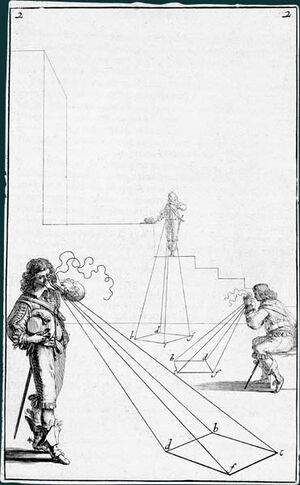Projective geometry (nonfiction)
Projective geometry is the branch of mathematics concerned with geometric properties that are invariant with respect to projective transformations. Projective geometry takes place in projective space, and has a selective set of basic geometric concepts. The basic intuitions are that projective space has more points than Euclidean space, for a given dimension, and that geometric transformations are permitted that transform the extra points (called "points at infinity") to Euclidean points, and vice versa.
Properties meaningful for projective geometry are respected by this new idea of transformation, which is more radical in its effects than can be expressed by a transformation matrix and translations (the affine transformations). The first issue for geometers is what kind of geometry is adequate for a novel situation. It is not possible to refer to angles in projective geometry as it is in Euclidean geometry, because angle is an example of a concept not invariant with respect to projective transformations. One source for projective geometry was indeed the theory of perspective. Another difference from elementary geometry is the way in which parallel lines can be said to meet in a point at infinity, once the concept is translated into projective geometry's terms. Again this notion has an intuitive basis, such as railway tracks meeting at the horizon in a perspective drawing. See projective plane for the basics of projective geometry in two dimensions.
Projective geometry is an elementary non-metrical form of geometry, meaning that it is not based on a concept of distance. In two dimensions it begins with the study of configurations of points and lines.
Projective geometry can also be seen as a geometry of constructions with a straight-edge alone.
Early theories of projective geometry were first established in the 1600s by Girard Desargues and others in their exploration of the principles of perspective art.
Projective geometry was mainly a development of the 1800s. This included the theory of complex projective space, the coordinates used (homogeneous coordinates) being complex numbers. Several major types of more abstract mathematics (including invariant theory, the Italian school of algebraic geometry, and Felix Klein's Erlangen programme resulting in the study of the classical groups) were based on projective geometry. It was also a subject with a large number of practitioners for its own sake, as synthetic geometry. Another topic that developed from axiomatic studies of projective geometry is finite geometry.
The topic of projective geometry is itself now divided into many research subtopics, two examples of which are projective algebraic geometry (the study of projective varieties) and projective differential geometry (the study of differential invariants of the projective transformations).
In higher dimensional spaces there are considered hyperplanes (that always meet), and other linear subspaces, which exhibit the principle of duality. The simplest illustration of duality is in the projective plane, where the statements "two distinct points determine a unique line" (i.e. the line through them) and "two distinct lines determine a unique point" (i.e. their point of intersection) show the same structure as propositions.
In the News
May 6, 1648: APTO field agents publish "Investigation into alleged Renaissance-era corruption of the Hindenburg disaster configuration files". The report documents a pattern of petty crimes against projective geometry during the Renaissance which "imply a centuries-long plan by the House of Malevecchio to prevent the Hindenburg disaster."
Fiction cross-reference
- Crimes against mathematical constants
- Geometry solvent
- Gnomon algorithm
- Gnomon Chronicles
- Mathematician
- Mathematics
Nonfiction cross-reference
- Girard Desargues (nonfiction)
- Mathematician (nonfiction)
- Mathematics (nonfiction)
- Pencil (mathematics) (nonfiction)
External links:
- Projective geometry @ Wikipedia

